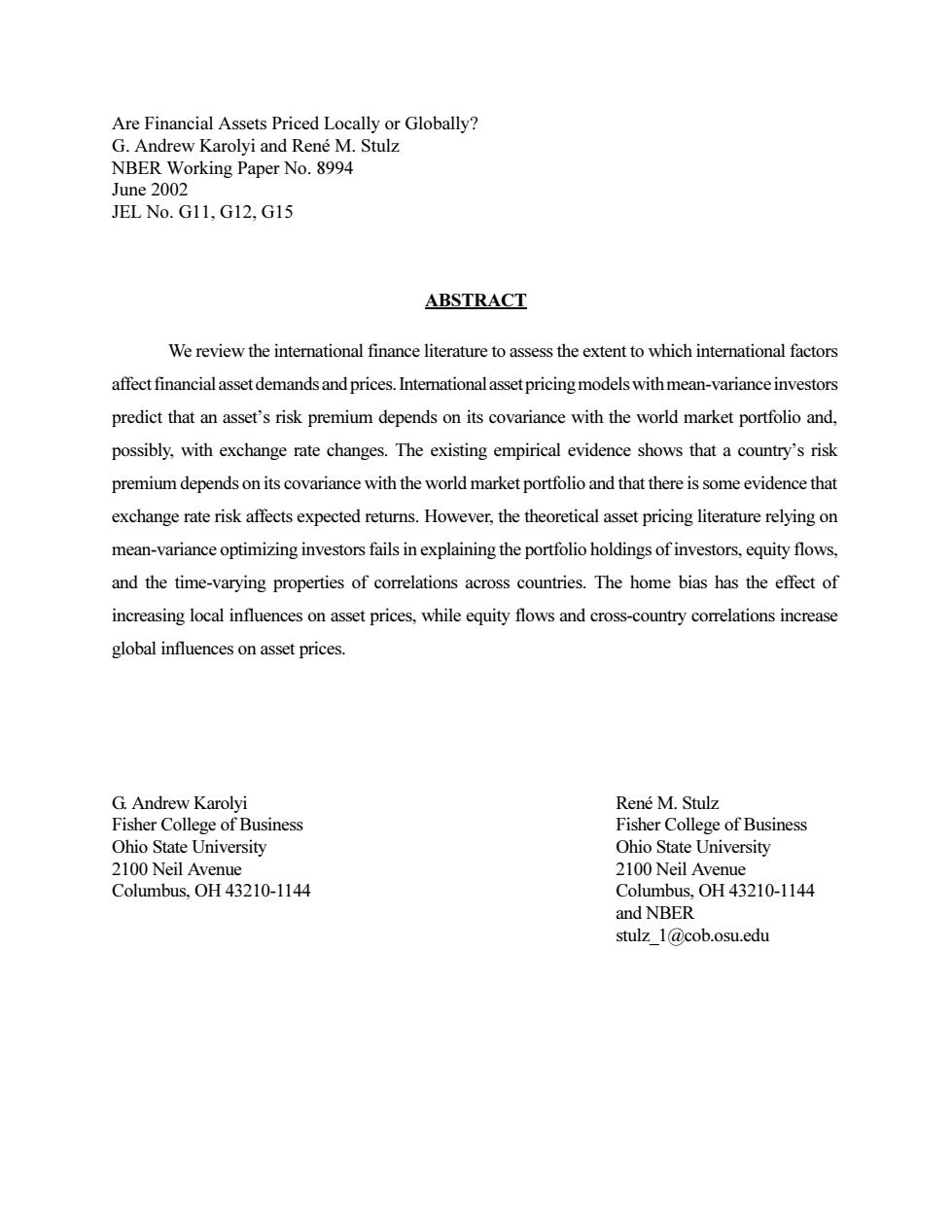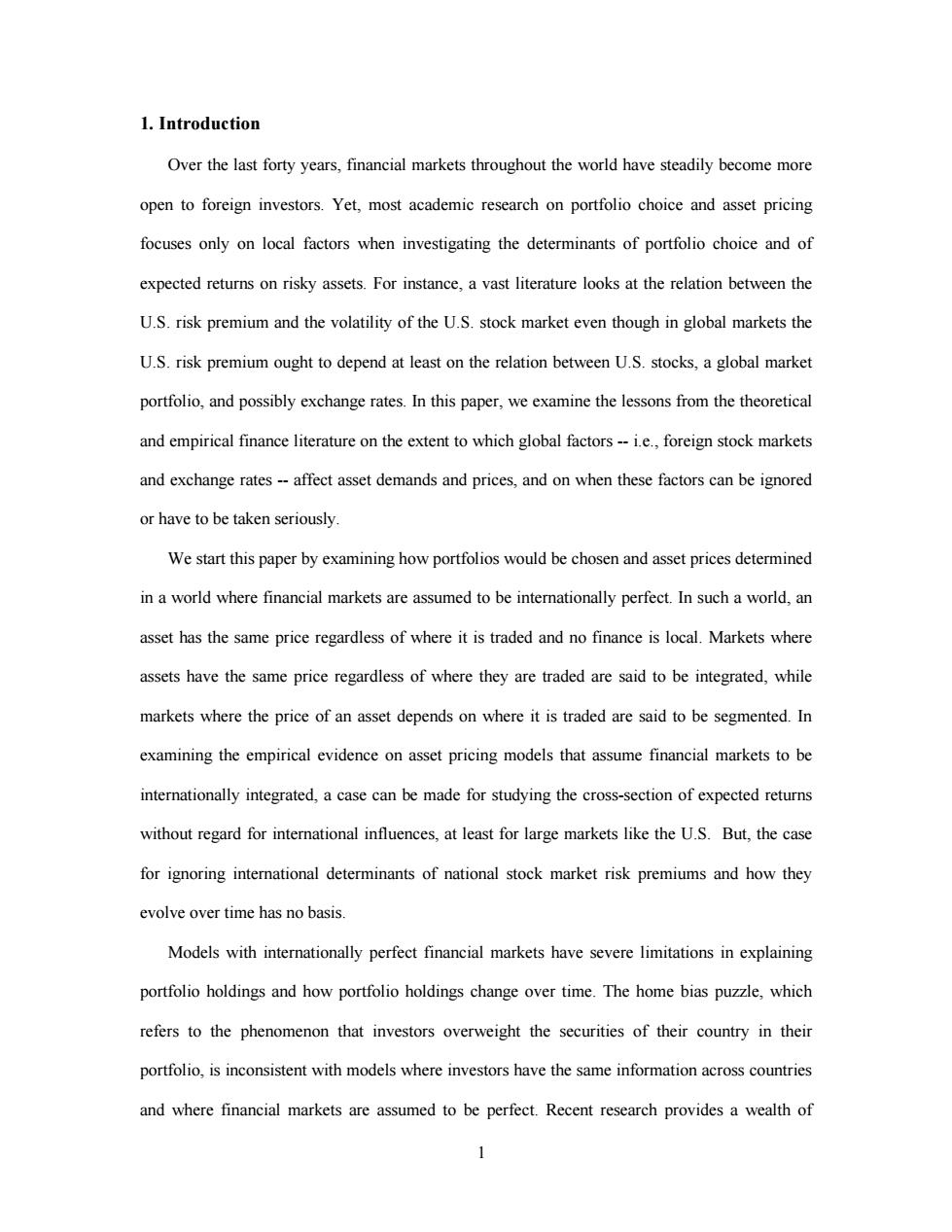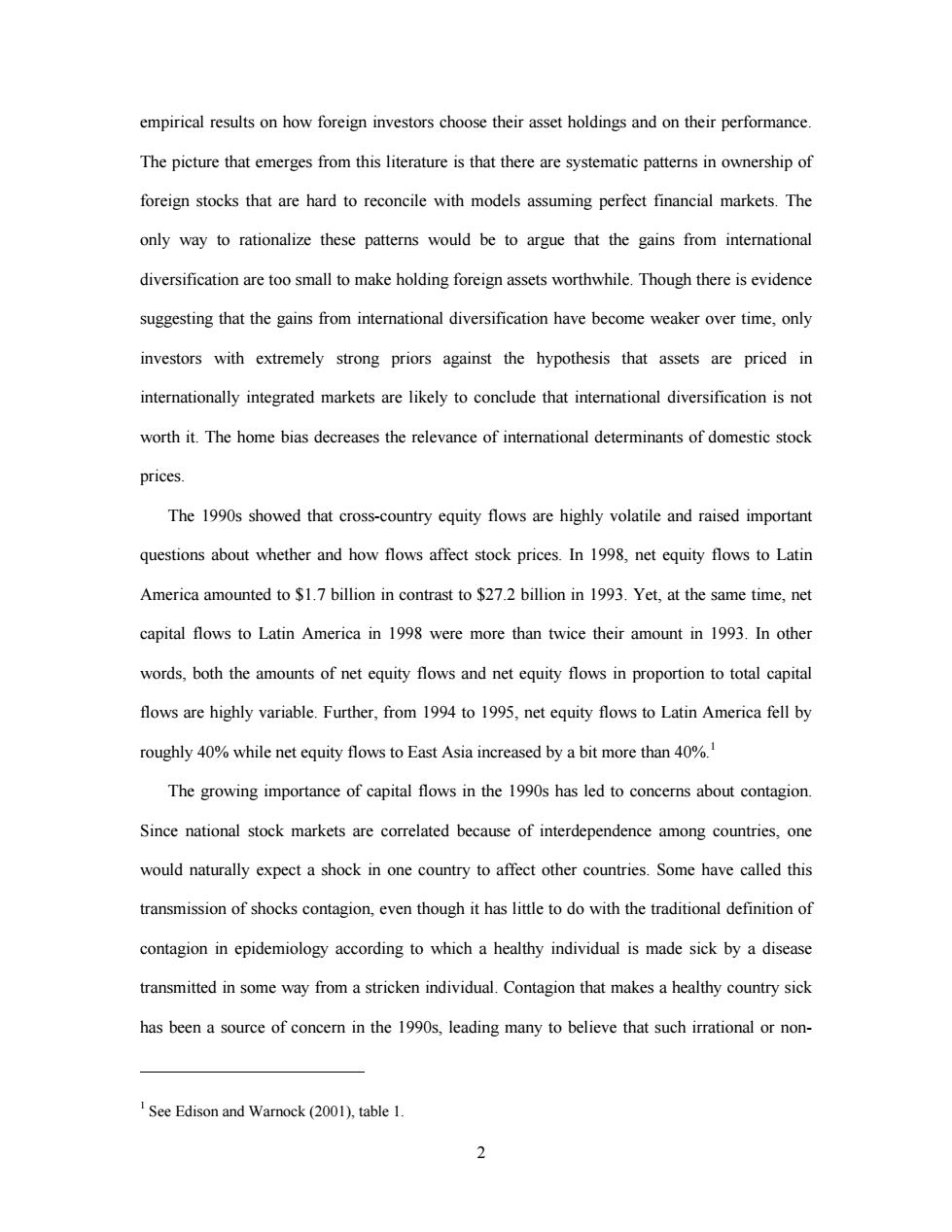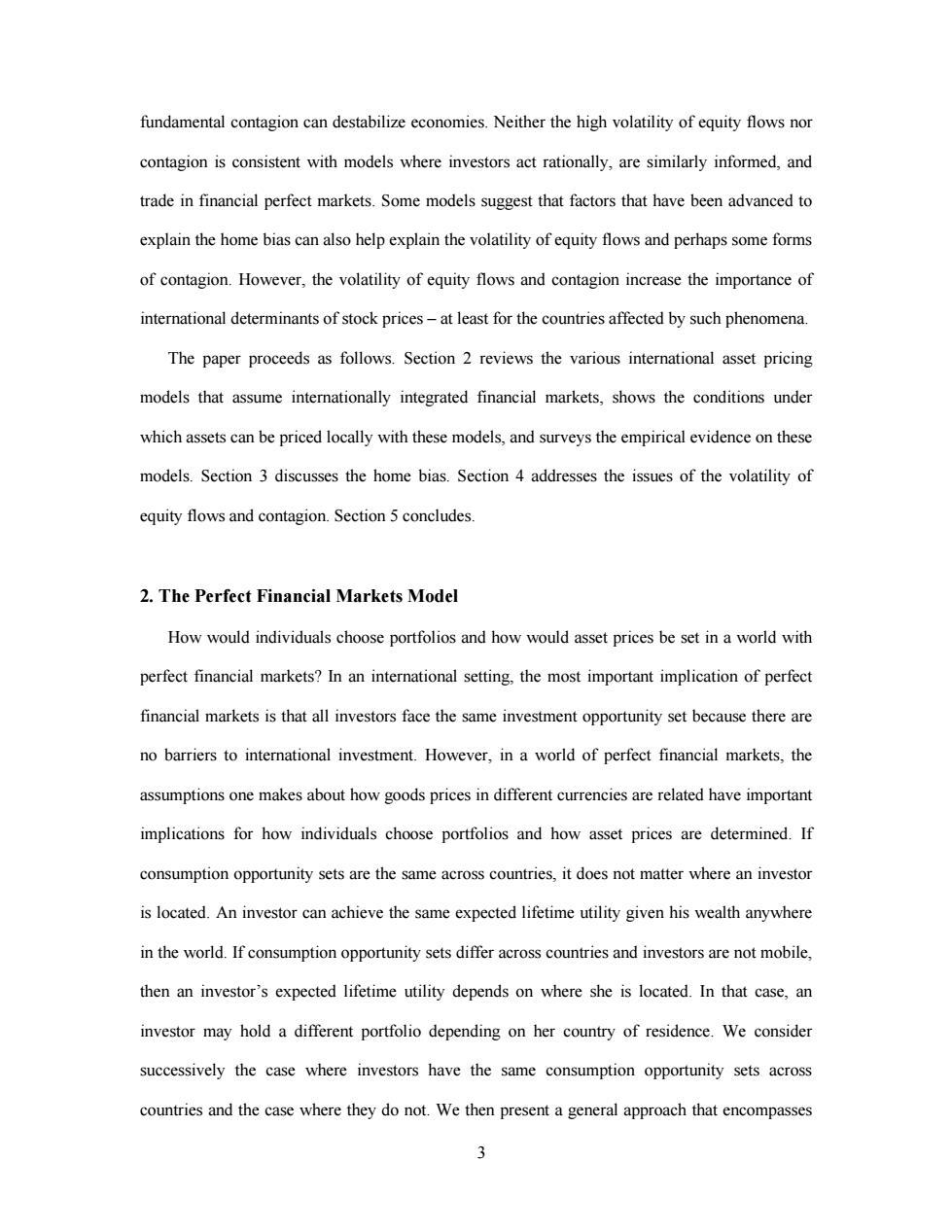
NBER WORKING PAPER SERIES ARE FINANCIAL ASSETS PRICED LOCALLY OR GLOBALLY? G.Andrew Karolyi Rene M.Stulz Working Paper 8994 http://www.nber.org/papers/w8994 NATIONAL BUREAU OF ECONOMIC RESEARCH 1050 Massachusetts Avenue Cambridge,MA 02138 June 2002 Prepared for the Handbook of the Economics of Finance,George Constantinides,Milton Harris,and Rene M.Stulz,eds.,North-Holland.We are grateful to Dong Lee and Boyce Watkins for research assistance,and to Michael Adler,Kee-Hong Bae,Warren Bailey,Soehnke Bartram,Laura Bottazzi,Magnus Dahlquist, Craig Doidge,Cheol Eun,Vihang Errunza,Jeff Frankel,Thomas Gehrig,John Griffin,Cam Harvey,Mervyn King,Paul O'Connell,Sergio Schmukler,Ravi Schukla,Enrique Sentana,Bruno Solnik,Christof Stahel, Lars Svensson,Linda Tesar,Frank Warnock,and Simon Wheatley for comments.The views expressed herein are those of the authors and not necessarily those of the National Bureau of Economic Research. 2002 by G.Andrew Karolyi and Rene M.Stulz.All rights reserved.Short sections oftext,not to exceed two paragraphs,may be quoted without explicit permission provided that full credit,including notice,is given to the source
NBER WORKING PAPER SERIES ARE FINANCIAL ASSETS PRICED LOCALLY OR GLOBALLY? G. Andrew Karolyi René M. Stulz Working Paper 8994 http://www.nber.org/papers/w8994 NATIONAL BUREAU OF ECONOMIC RESEARCH 1050 Massachusetts Avenue Cambridge, MA 02138 June 2002 Prepared for the Handbook of the Economics of Finance, George Constantinides, Milton Harris, and René M. Stulz, eds., North-Holland. We are grateful to Dong Lee and Boyce Watkins for research assistance, and to Michael Adler, Kee-Hong Bae, Warren Bailey, Soehnke Bartram, Laura Bottazzi, Magnus Dahlquist, Craig Doidge, Cheol Eun, Vihang Errunza, Jeff Frankel, Thomas Gehrig, John Griffin, Cam Harvey, Mervyn King, Paul O’Connell, Sergio Schmukler, Ravi Schukla, Enrique Sentana, Bruno Solnik, Christof Stahel, Lars Svensson, Linda Tesar, Frank Warnock, and Simon Wheatley for comments. The views expressed herein are those of the authors and not necessarily those of the National Bureau of Economic Research. © 2002 by G. Andrew Karolyi and René M. Stulz. All rights reserved. Short sections of text, not to exceed two paragraphs, may be quoted without explicit permission provided that full credit, including © notice, is given to the source

Are Financial Assets Priced Locally or Globally? G.Andrew Karolyi and Rene M.Stulz NBER Working Paper No.8994 June 2002 JEL No.G11,G12,G15 ABSTRACT We review the international finance literature to assess the extent to which international factors affect financial asset demands and prices.International asset pricing models with mean-variance investors predict that an asset's risk premium depends on its covariance with the world market portfolio and, possibly,with exchange rate changes.The existing empirical evidence shows that a country's risk premium depends on its covariance with the world market portfolio and that there is some evidence that exchange rate risk affects expected returns.However,the theoretical asset pricing literature relying on mean-variance optimizing investors fails in explaining the portfolio holdings of investors,equity flows, and the time-varying properties of correlations across countries.The home bias has the effect of increasing local influences on asset prices,while equity flows and cross-country correlations increase global influences on asset prices. G.Andrew Karolyi Rene M.Stulz Fisher College of Business Fisher College of Business Ohio State University Ohio State University 2100 Neil Avenue 2100 Neil Avenue Columbus,OH 43210-1144 Columbus,OH 43210-1144 and NBER stulz 1@cob.osu.edu
Are Financial Assets Priced Locally or Globally? G. Andrew Karolyi and René M. Stulz NBER Working Paper No. 8994 June 2002 JEL No. G11, G12, G15 ABSTRACT We review the international finance literature to assess the extent to which international factors affect financial asset demands and prices. International asset pricing models with mean-variance investors predict that an asset’s risk premium depends on its covariance with the world market portfolio and, possibly, with exchange rate changes. The existing empirical evidence shows that a country’s risk premium depends on its covariance with the world market portfolio and that there is some evidence that exchange rate risk affects expected returns. However, the theoretical asset pricing literature relying on mean-variance optimizing investors fails in explaining the portfolio holdings of investors, equity flows, and the time-varying properties of correlations across countries. The home bias has the effect of increasing local influences on asset prices, while equity flows and cross-country correlations increase global influences on asset prices. G. Andrew Karolyi René M. Stulz Fisher College of Business Fisher College of Business Ohio State University Ohio State University 2100 Neil Avenue 2100 Neil Avenue Columbus, OH 43210-1144 Columbus, OH 43210-1144 and NBER stulz_1@cob.osu.edu

1.Introduction Over the last forty years,financial markets throughout the world have steadily become more open to foreign investors.Yet,most academic research on portfolio choice and asset pricing focuses only on local factors when investigating the determinants of portfolio choice and of expected returns on risky assets.For instance,a vast literature looks at the relation between the U.S.risk premium and the volatility of the U.S.stock market even though in global markets the U.S.risk premium ought to depend at least on the relation between U.S.stocks,a global market portfolio,and possibly exchange rates.In this paper,we examine the lessons from the theoretical and empirical finance literature on the extent to which global factors--i.e.,foreign stock markets and exchange rates--affect asset demands and prices,and on when these factors can be ignored or have to be taken seriously. We start this paper by examining how portfolios would be chosen and asset prices determined in a world where financial markets are assumed to be internationally perfect.In such a world,an asset has the same price regardless of where it is traded and no finance is local.Markets where assets have the same price regardless of where they are traded are said to be integrated,while markets where the price of an asset depends on where it is traded are said to be segmented.In examining the empirical evidence on asset pricing models that assume financial markets to be internationally integrated,a case can be made for studying the cross-section of expected returns without regard for international influences,at least for large markets like the U.S.But,the case for ignoring international determinants of national stock market risk premiums and how they evolve over time has no basis. Models with internationally perfect financial markets have severe limitations in explaining portfolio holdings and how portfolio holdings change over time.The home bias puzzle,which refers to the phenomenon that investors overweight the securities of their country in their portfolio,is inconsistent with models where investors have the same information across countries and where financial markets are assumed to be perfect.Recent research provides a wealth of 1
1 1. Introduction Over the last forty years, financial markets throughout the world have steadily become more open to foreign investors. Yet, most academic research on portfolio choice and asset pricing focuses only on local factors when investigating the determinants of portfolio choice and of expected returns on risky assets. For instance, a vast literature looks at the relation between the U.S. risk premium and the volatility of the U.S. stock market even though in global markets the U.S. risk premium ought to depend at least on the relation between U.S. stocks, a global market portfolio, and possibly exchange rates. In this paper, we examine the lessons from the theoretical and empirical finance literature on the extent to which global factors -- i.e., foreign stock markets and exchange rates -- affect asset demands and prices, and on when these factors can be ignored or have to be taken seriously. We start this paper by examining how portfolios would be chosen and asset prices determined in a world where financial markets are assumed to be internationally perfect. In such a world, an asset has the same price regardless of where it is traded and no finance is local. Markets where assets have the same price regardless of where they are traded are said to be integrated, while markets where the price of an asset depends on where it is traded are said to be segmented. In examining the empirical evidence on asset pricing models that assume financial markets to be internationally integrated, a case can be made for studying the cross-section of expected returns without regard for international influences, at least for large markets like the U.S. But, the case for ignoring international determinants of national stock market risk premiums and how they evolve over time has no basis. Models with internationally perfect financial markets have severe limitations in explaining portfolio holdings and how portfolio holdings change over time. The home bias puzzle, which refers to the phenomenon that investors overweight the securities of their country in their portfolio, is inconsistent with models where investors have the same information across countries and where financial markets are assumed to be perfect. Recent research provides a wealth of

empirical results on how foreign investors choose their asset holdings and on their performance. The picture that emerges from this literature is that there are systematic patterns in ownership of foreign stocks that are hard to reconcile with models assuming perfect financial markets.The only way to rationalize these patterns would be to argue that the gains from international diversification are too small to make holding foreign assets worthwhile.Though there is evidence suggesting that the gains from international diversification have become weaker over time,only investors with extremely strong priors against the hypothesis that assets are priced in internationally integrated markets are likely to conclude that international diversification is not worth it.The home bias decreases the relevance of international determinants of domestic stock prices. The 1990s showed that cross-country equity flows are highly volatile and raised important questions about whether and how flows affect stock prices.In 1998,net equity flows to Latin America amounted to $1.7 billion in contrast to $27.2 billion in 1993.Yet,at the same time,net capital flows to Latin America in 1998 were more than twice their amount in 1993.In other words,both the amounts of net equity flows and net equity flows in proportion to total capital flows are highly variable.Further,from 1994 to 1995,net equity flows to Latin America fell by roughly 40%while net equity flows to East Asia increased by a bit more than 40%. The growing importance of capital flows in the 1990s has led to concerns about contagion. Since national stock markets are correlated because of interdependence among countries,one would naturally expect a shock in one country to affect other countries.Some have called this transmission of shocks contagion,even though it has little to do with the traditional definition of contagion in epidemiology according to which a healthy individual is made sick by a disease transmitted in some way from a stricken individual.Contagion that makes a healthy country sick has been a source of concern in the 1990s,leading many to believe that such irrational or non- I See Edison and Warnock(2001),table 1. 2
2 empirical results on how foreign investors choose their asset holdings and on their performance. The picture that emerges from this literature is that there are systematic patterns in ownership of foreign stocks that are hard to reconcile with models assuming perfect financial markets. The only way to rationalize these patterns would be to argue that the gains from international diversification are too small to make holding foreign assets worthwhile. Though there is evidence suggesting that the gains from international diversification have become weaker over time, only investors with extremely strong priors against the hypothesis that assets are priced in internationally integrated markets are likely to conclude that international diversification is not worth it. The home bias decreases the relevance of international determinants of domestic stock prices. The 1990s showed that cross-country equity flows are highly volatile and raised important questions about whether and how flows affect stock prices. In 1998, net equity flows to Latin America amounted to $1.7 billion in contrast to $27.2 billion in 1993. Yet, at the same time, net capital flows to Latin America in 1998 were more than twice their amount in 1993. In other words, both the amounts of net equity flows and net equity flows in proportion to total capital flows are highly variable. Further, from 1994 to 1995, net equity flows to Latin America fell by roughly 40% while net equity flows to East Asia increased by a bit more than 40%.1 The growing importance of capital flows in the 1990s has led to concerns about contagion. Since national stock markets are correlated because of interdependence among countries, one would naturally expect a shock in one country to affect other countries. Some have called this transmission of shocks contagion, even though it has little to do with the traditional definition of contagion in epidemiology according to which a healthy individual is made sick by a disease transmitted in some way from a stricken individual. Contagion that makes a healthy country sick has been a source of concern in the 1990s, leading many to believe that such irrational or non- 1 See Edison and Warnock (2001), table 1

fundamental contagion can destabilize economies.Neither the high volatility of equity flows nor contagion is consistent with models where investors act rationally,are similarly informed,and trade in financial perfect markets.Some models suggest that factors that have been advanced to explain the home bias can also help explain the volatility of equity flows and perhaps some forms of contagion.However,the volatility of equity flows and contagion increase the importance of international determinants of stock prices-at least for the countries affected by such phenomena. The paper proceeds as follows.Section 2 reviews the various international asset pricing models that assume internationally integrated financial markets,shows the conditions under which assets can be priced locally with these models,and surveys the empirical evidence on these models.Section 3 discusses the home bias.Section 4 addresses the issues of the volatility of equity flows and contagion.Section 5 concludes. 2.The Perfect Financial Markets Model How would individuals choose portfolios and how would asset prices be set in a world with perfect financial markets?In an international setting,the most important implication of perfect financial markets is that all investors face the same investment opportunity set because there are no barriers to international investment.However,in a world of perfect financial markets,the assumptions one makes about how goods prices in different currencies are related have important implications for how individuals choose portfolios and how asset prices are determined.If consumption opportunity sets are the same across countries,it does not matter where an investor is located.An investor can achieve the same expected lifetime utility given his wealth anywhere in the world.If consumption opportunity sets differ across countries and investors are not mobile, then an investor's expected lifetime utility depends on where she is located.In that case,an investor may hold a different portfolio depending on her country of residence.We consider successively the case where investors have the same consumption opportunity sets across countries and the case where they do not.We then present a general approach that encompasses 3
3 fundamental contagion can destabilize economies. Neither the high volatility of equity flows nor contagion is consistent with models where investors act rationally, are similarly informed, and trade in financial perfect markets. Some models suggest that factors that have been advanced to explain the home bias can also help explain the volatility of equity flows and perhaps some forms of contagion. However, the volatility of equity flows and contagion increase the importance of international determinants of stock prices – at least for the countries affected by such phenomena. The paper proceeds as follows. Section 2 reviews the various international asset pricing models that assume internationally integrated financial markets, shows the conditions under which assets can be priced locally with these models, and surveys the empirical evidence on these models. Section 3 discusses the home bias. Section 4 addresses the issues of the volatility of equity flows and contagion. Section 5 concludes. 2. The Perfect Financial Markets Model How would individuals choose portfolios and how would asset prices be set in a world with perfect financial markets? In an international setting, the most important implication of perfect financial markets is that all investors face the same investment opportunity set because there are no barriers to international investment. However, in a world of perfect financial markets, the assumptions one makes about how goods prices in different currencies are related have important implications for how individuals choose portfolios and how asset prices are determined. If consumption opportunity sets are the same across countries, it does not matter where an investor is located. An investor can achieve the same expected lifetime utility given his wealth anywhere in the world. If consumption opportunity sets differ across countries and investors are not mobile, then an investor’s expected lifetime utility depends on where she is located. In that case, an investor may hold a different portfolio depending on her country of residence. We consider successively the case where investors have the same consumption opportunity sets across countries and the case where they do not. We then present a general approach that encompasses